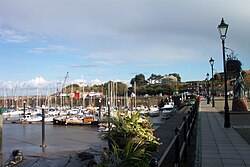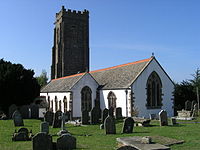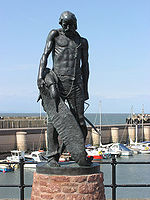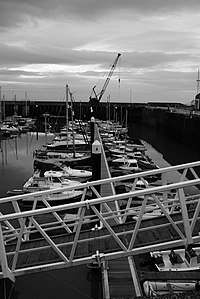Watchet
| Watchet | |
| Somerset | |
|---|---|
 Watchet Harbour | |
| Location | |
| Grid reference: | ST074431 |
| Location: | 51°10’46"N, 3°19’27"W |
| Data | |
| Population: | 4,401 (2001) |
| Post town: | Watchet |
| Postcode: | TA23 |
| Dialling code: | 01984 |
| Local Government | |
| Council: | Somerset West and Taunton |
| Parliamentary constituency: |
Bridgwater & W. Somerset |
Watchet is a small harbour town in Somerset, with an approximate population of 4,400. It is 15 miles west of Bridgwater, 15 miles north-west of Taunton, and nine miles east of Minehead. The parish includes the hamlet of Beggearn Huish.
The town is at the mouth of the Washford River on Bridgwater Bay, part of the Bristol Channel, and on the edge of Exmoor.
Samuel Taylor Coleridge's poem The Rime of the Ancient Mariner was written whilst travelling through Watchet and the surrounding area.
History
Watchet is believed to be the place where Saint Decuman was killed and the 15th century, Grade I listed, Church of St Decuman is dedicated to him.[1]
There is no sign locally of Roman occupation, but the Anglo-Saxons took Watchet from the native Britons around AD 680. Under Alfred the Great (AD 871−901) Watchet became an important Saxon port, and the site of a mint with coins found as far away as Copenhagen and Stockholm.
The Anglo-Saxon Chronicle records that Watchet (Wecedport) was plundered by Danes led by Earls it names Ohtor and a Hroald in 987 and 997.[2]
Harbour
Watchet developed as a town thanks to its closeness to the minerals within the Brendon Hills, and its access to the River Severn for onward shipping. Aside from local ships plying trade across the river, from 1564 onwards the port was used for import of salt and wine from France.[3]
In 1643 during the Civil War, a Royalist ship was sent to Watchet to reinforce for the siege of Dunster Castle. Parliamentarian Captain Popham ordered his mounted troops into the sea with the tide on the ebb, and with the ship unable to move, attacked the ship with fire from their carbines. Taken by surprise and under heavy attack, the Royalist commander surrendered the ship, resulting in a ship technically at sea being captured by troops on horseback.[4][5]
The primitive jetty was damaged in a storm of 1659, so that in 1708 lading local wool merchant Sir William Wyndham built a new harbour costing £1,000, with a stronger pier. The main export at this time was kelp, made by burning seaweed for use in glass making.
19th century expansion
In the 19th century trade increased with the export of iron ore from the Brendon Hills mainly to Newport, Monmouthshire for onward trasportation to the Ebbw Vale Steelworks,[6] paper, flour and gypsum.[3] Rags imported from France were used in paper making at Watchet Paper Mill.[6]
In 1843 the esplanade was built by the fourth Earl of Egremont, and in 1855 a new harbour was commissioned to cope with increased iorn ore trade. A new east pier and wharf was completed in 1861−62 by James Abernethy. This allowed shipping movement to reach a peak, with over 1,100 ship movements per annum.
Late 19th century
Harbour trade was aided by the coming of the railway, with two independent railways terminating at Watchet from the mid 1860s. The West Somerset Mineral Railway ran down from the iron mines on the Brendon Hills, and the West Somerset Railway came up from the Bristol & Exeter Railway at Norton Fitzwarren.[3]
In 1862, the cast-iron Watchet lighthouse was built by Hennet Spink and Else of Bridgwater. [7] In September 2012, Princess Anne unveiled a plaque to celebrate the 150th anniversary of the lighthouse. [8]
20th century
The mines and West Somerset Mineral Railway closed in 1898. The West Somerset Railway, extended from Watchet to Minehead in 1874, survived as part of British Rail until 1971. Reopened as a heritage railway, it still operates today.
In 1900 and 1903 a series of gales breached the breakwater and East Pier with the loss of several vessels each time and subsequent repairs.[3]
Before Second World War at a site between Watchet and Doniford a gunnery range was established for various army units to practice anti-aircraft gunnery. Unmanned target aircraft were towed by planes from [[|Westonzoyland|RAF Weston Zoyland]] and later were fired from catapults over the sea.[9] Little of the camp buildings survive and it is now the site of a holiday park.[10]
The port remained open to service the papermills, importing wood pulp and esparto grass from Russia and Scandinavia, using mainly East European registered vessels after the War. Requiring a return load, the result was that Watchet became a leading British port for the export of car parts, tractors and other industrial goods. However, with the replacement of coal with oil from the mid-1960s, the port traffic began to decline.
Church

St Decuman's Church stands on a hill top between Watchet and Williton. An earlier church was situated by the sea at Dawes castle (probably the original site of Watchet) but was abandoned because of sea erosion. When the church was rebuilt in the 12th century it appears that the bones of St Decuman were moved. The chancel of the present church is unusually wide and may have housed the tomb of St Decuman. The "Translation of Saint Decuman" used to be celebrated.
The Norman church was rebuilt in the 15th and 16th centuries when the central tower was demolished and the present one built at the west end.
The organ was presented to the church in 1933 by W. Wyndham.
Lifeboat
The Royal National Lifeboat Institution stationed a lifeboat at Watchet in 1875. The station was closed in 1944 by which time the nearby station at Minehead had been equipped with a motor lifeboat that could cover the area around Watchet.[11] The boat was launched from the slipway at the western corner of the harbour, but the boat house was at the southern corner near the railway station and the boat was taken along the quay on a carriage. Since closure the boat house has been converted into a library.
Other landmarks

The principal landmark in Watchet is the town's harbour and the surrounding quaysides and narrow streets. In commercial use until 2000, the harbour has now been converted into a marina.
The commercial esplanade has been refurbished with new shelters, information points, and the provision of new paving in some areas, as well as railings, lamps, curved benches, planters and new tree plantings.[12] There are several museums in the town, including the Market House Museum, which explores the history of the town and its harbour, and the Watchet Boat Museum, which displays the unusual local flatner boats and associated artefacts.[13]
Adjacent to the harbour is Watchet station. This is now an intermediate stop on the West Somerset Railway, a largely steam-operated heritage railway that links Bishops Lydeard, near Taunton, with Minehead. The trackbed of the old West Somerset Mineral Railway now forms a path, which can be followed from the harbour at Watchet to Washford station, also on the West Somerset Railway.[13][14]
The foreshore at Watchet is rocky, with a high 20 feet (6 m) tidal range. The cliffs between Watchet and Blue Anchor show a distinct pale, greenish blue colour, resulting from the coloured alabaster found there. The name "Watchet" or "Watchet Blue" was used in the 16th century to denote this colour.[5][15]
Daw's Castle, about ha;f a mile west of Watchet, is a hill fort situated on a sea cliff about 262 feet above the sea. The fort may be of Iron Age origin, but was (re)built and fortified as a burh by King Alfred, as part of his defence against Viking raids from the Bristol Channel around 878.[16][17]
Cleeve Abbey, one of the best preserved mediæval monasteries in Britain, lies about 2 miles west of Watchet, in the village of Washford. Dunster Castle is a further 4 miles in the same direction.

Outside links
| ("Wikimedia Commons" has material about Watchet) |
References
- ↑ National Heritage List 1057662: Parish church of St Decuman
- ↑ Waite, Vincent (1964). Portrait of the Quantocks. London: Robert Hale. ISBN 0-7091-1158-4.
- ↑ 3.0 3.1 3.2 3.3 Farr, Grahame (1954). Somerset Harbours. London: Christopher Johnson. pp. 125–137.
- ↑ "Maritime history". Watchet Museum. http://www.watchetmuseum.co.uk/maritime.php. Retrieved 5 July 2013.
- ↑ 5.0 5.1 Leete-Hodge, Lornie (1985). Curiosities of Somerset. Bodmin: Bossiney Books. pp. 41–42. ISBN 0-906456-98-3. Cite error: Invalid
<ref>tag; name "curio" defined multiple times with different content - ↑ 6.0 6.1 "Watchet harbour". Ports.org.uk. http://www.ports.org.uk/port.asp?id=218. Retrieved 5 Jul 2013.
- ↑ This is Somerset http://www.thisissomerset.co.uk/Princess-Royal-pays-visit-Watchet-lighthouse/story-16956765-detail/story.html
- ↑ BBC News http://www.bbc.co.uk/news/uk-england-somerset-19668089
- ↑ Berryman, David (2006). Somerset airfields in the Second World War. Newbury: Countryside Books. pp. 127–131. ISBN 1-85306-864-0.
- ↑ "Doniford Camp, Doniford". Somerset Historic Environment Record. Somerset County Council. http://webapp1.somerset.gov.uk/her/details.asp?prn=15839. Retrieved 22 January 2011.
- ↑ Denton, Tony (2009). Handbook 2009. Shrewsbury: Lifeboat Enthusiasts Society. p. 60.
- ↑ "Watchet esplanade enhancement". Somerset Rural Renaissance. http://www.somerset-rural-renaissance.co.uk/projects-watchet-esplanade-enhancement.html. Retrieved 14 May 2010.
- ↑ 13.0 13.1 "Watchet". West Somerset Railway. http://www.west-somerset-railway.co.uk/article.php/18/watchet_/. Retrieved 7 June 2012.
- ↑ "Things to do". Watchet Town Council. http://www.watchettowncouncil.org/?page=do. Retrieved 2008-10-08.
- ↑ "Nearby". Pilgrim Corner. http://www.pilgrimcorner.co.uk/nearby.html. Retrieved 7 June 2012.
- ↑ Adkins, Lesley; Roy Adkins (1992). A Field Guide to Somerset Archaeology. Wimborne, Dorset: Dovecote Press. p. 46. ISBN 0-946159-94-7.
- ↑ Aston, Michael (1982). Ian Burrow. ed. The Archaeology of Somerset. ISBN 0-86183-028-8.
